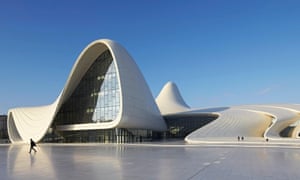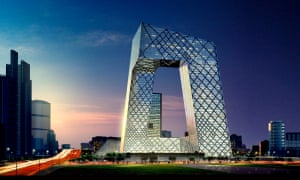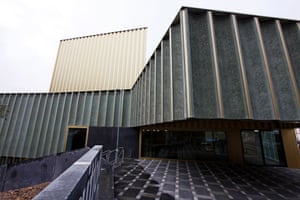
Revels in sensuous freedoms … Zaha Hadid’s Heydar Aliyev centre in Azerbaijan. Photograph: Alamy
Architects seldom make the front pages of newspapers. Patrik Schumacher recently managed it, though, getting himself on to the cover of the Evening Standard after a speech in which he advocated privatising all social housing and all public space – including Hyde Park – and espoused intensified gentrification of inner city areas. His advocacy on behalf of plutocrats reached hilariously villainous levels when he said of second home owners in London: “even if they’re only here for a few weeks and throw some key parties, these are amazing multiplying events”.
This is “neoliberal” rhetoric at its purest. Neoliberalism – a form of free market fundamentalism that effectively came to power at the turn of the 1980s with the election of such enthusiasts for Friedrich Hayek and Milton Friedman as Margaret Thatcher and Ronald Reagan – is an unusual concept, largely because it extends out of economics and into philosophy and the way people see the world. As Thatcher once said, “economics is the method, the aim is to change the soul”. According to Douglas Spencer, one of the best places to see this is architecture.
Schumacher now heads Zaha Hadid Architects, after the early death of his long-term creative partner in 2016. He is a figurehead of a digital architecture described as “parametricism”, which he has tried to popularise through a series of densely theoretical, admirably pugnacious texts in the architectural press over the last 10 years. The speech that got him into the national news is a somewhat blunter expression of the political ideas that go with the seemingly apolitical language he used to describe parametricism, an architecture which, in his words, “interarticulates, morphs, deterritorialises, deforms, iterates, uses splines, nurbs, generative components, scripts rather than models”. This is a little bit more complex than “build on Hyde Park”.
For Spencer, this is only the vulgar statement of something that has previously been expressed in architectural-philosophical jargon. For him, Schumacher’s buildings with Zaha Hadid, characterised by “pliant envelopes and organic contours”, carefully hide the structures of support, not to mention the human labour and political power that actually builds; their “workings are beyond our ken”. The buildings described in this book include a college in Greenwich, a BMW factory in Leipzig, the China Central Television headquarters in Beijing, New Street station in Birmingham and a John Lewis store in Leicester. The “neoliberal eye”, Spencer argues, “does not apprehend, calculate or gauge”. Instead, it “surfs the field of vision, revelling in the sensuous freedoms offered up to it”.

FacebookTwitterPinterest An artist’s impression of the design for Rem Koolhaas’s CCTV building in Beijing, China. Photograph: OMA/Corbis
Architects such as Schumacher, Greg Lynn and the team of Alejandro Zaera-Polo and Farshid Moussavi (formerly Foreign Office Architects, designers of New Street station and the Leicester John Lewis) arrived at this point via a circuitous route through continental philosophy and architectural theory, only later coming to the neoliberal classics (by Hayek and Friedman). Resistance is
not only futile, it’s misunderstanding; there is no alternative. Hayek argued that in the social democratic era human systems were so complex that to try and manage or plan them could only lead to totalitarianism. With Schumacher, this idea is translated into a “radical free-market urbanism”, where all controls on flows must be removed, and “the market will discover the most productive mix and arrangement of land uses, a distribution that garners synergies and maximises overall value” (an excitable jargon is a constant in these circles). This belief in “the market” left to its own devices, despite the evidence of the 2008 financial crisis that an unregulated, complex, computerised financial system leads both to endemic corruption and to disastrous economic collapses, has a touching, eschatological certainty to it. It is no surprise to learn that Schumacher is a former member of a Marxist sect.
Like many architectural theorists, Spencer is better on buildings as theorems than as things
But what does it mean for design? Zaera-Polo’s new facade and station hall for Birmingham New Street was downgraded so relentlessly in its construction – via impeccably neoliberal methods such as design and build contracts, public-private partnerships and “value engineering”, which take power out of the hands of architects and leave it with businesses – that the smooth surfaces and seamless flows are constantly interrupted by cheesy adverts and cheap materials. Schumacher and Hadid’s Riverside Transport Museum in Glasgow, or their Guangzhou Opera House, went through a similar process of cost-cutting vulgarisation. Like many architectural theorists, Spencer is better on buildings as theorems than as things, which runs contrary to his laudable emphasis on politics and labour. In the process, he inadvertently presents this architecture as seductively as it exists in the computer visuals, rather than in its usually tawdry reality
.
FacebookTwitterPinterest Nottingham Contemporary art gallery, designed by Caruso St John. Photograph: David Sillitoe for the Guardian
These buildings are beginning to date. In architecture today, Schumacher often resembles a futurist relic, keeping the pure flame of pre-crisis “irrational exuberance” burning in a chastened era. The architecture that wins awards and contracts after the financial crisis is different. It is exemplified at its best in the discipline and craftsmanship of the art galleries Caruso St John architects have designed in Nottingham and Vauxhall, south London – and at its worst in the brick grids of luxury flats that increasingly dominate the skylines of London and Manchester. The social processes these latter buildings enforce – displacement of the poor, privatisation of public space, the decimation of social housing – are exactly those which Schumacher argues for in wilfully offensive terms.
Certainly, there are neoliberal architects, and their vertiginous designs represent their attempt to embody the dominant political and economic ideas of our time. But neoliberalism can easily do without them, and structures of power may prefer to cover their ongoing project in much more homely, reassuring architectural forms. This book is about the architecture of Tony Blair’s vision of society – ruthless for those who can’t go with the flow, rewarding for those who “aim high”. Theresa May’s architecture will be dull and disciplinarian.
is published by Bloomsbury Academic

FacebookTwitterPinterest Nottingham Contemporary art gallery, designed by Caruso St John. Photograph: David Sillitoe for the Guardian
These buildings are beginning to date. In architecture today, Schumacher often resembles a futurist relic, keeping the pure flame of pre-crisis “irrational exuberance” burning in a chastened era. The architecture that wins awards and contracts after the financial crisis is different. It is exemplified at its best in the discipline and craftsmanship of the art galleries Caruso St John architects have designed in Nottingham and Vauxhall, south London – and at its worst in the brick grids of luxury flats that increasingly dominate the skylines of London and Manchester. The social processes these latter buildings enforce – displacement of the poor, privatisation of public space, the decimation of social housing – are exactly those which Schumacher argues for in wilfully offensive terms.
Certainly, there are neoliberal architects, and their vertiginous designs represent their attempt to embody the dominant political and economic ideas of our time. But neoliberalism can easily do without them, and structures of power may prefer to cover their ongoing project in much more homely, reassuring architectural forms. This book is about the architecture of Tony Blair’s vision of society – ruthless for those who can’t go with the flow, rewarding for those who “aim high”. Theresa May’s architecture will be dull and disciplinarian.
is published by Bloomsbury Academic
No comments:
Post a Comment